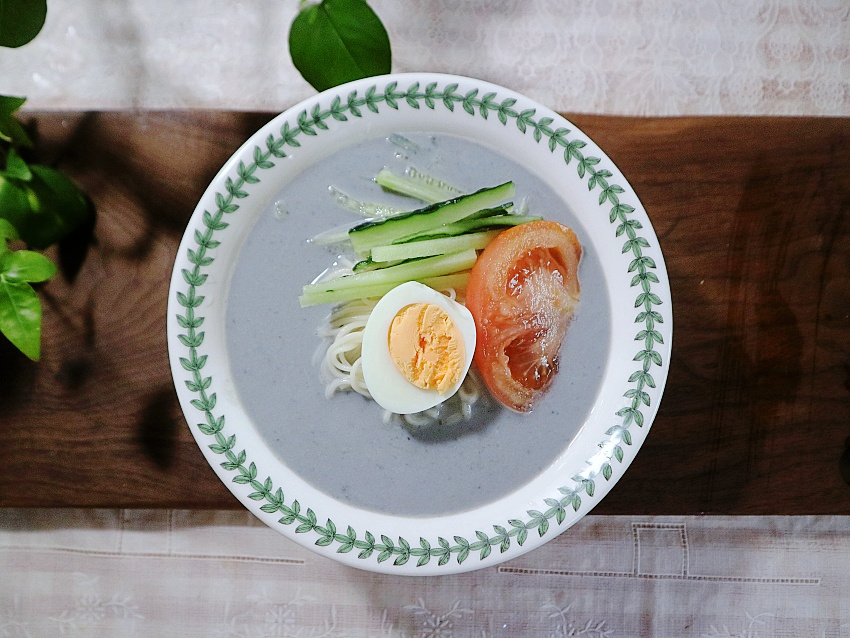Seoritae Bean Noodles (Kongguksu): A Creamy & Nutty Summer Delicacy
Homemade Seoritae Kongguksu Recipe: The Ultimate Guide to Making Rich Soybean Broth and Noodles

Beat the summer heat with a refreshing and satisfying bowl of Kongguksu! This recipe focuses on using seoritae (black soybeans) to create a deeply flavorful and nutty soybean broth. We’ll guide you through every step, from soaking the beans to perfectly cooking the noodles and arranging beautiful toppings. #SeoritaeKongguksu #BlackSoybeanNoodles #KongguksuRecipe #SummerDish #HealthyEating Discover the secrets to perfectly soaked and boiled beans for an unbelievably smooth and rich soy milk base. Whether enjoyed as a refreshing soup or paired with noodles, this homemade soy milk is far superior to store-bought options and makes for a wonderfully filling breakfast or light meal. Get ready to savor this quintessential Korean summer dish!
Kongguksu Ingredients- Seoritae (black soybeans) 3 cups
- Sesame seeds 1 Tbsp
- Wheat noodles or somen noodles 1 serving
- Cucumber 5cm piece
- Cherry tomato 1 piece
- Boiled egg 1
- Salt to taste
- Sugar to taste (optional)
Cooking Instructions
Step 1
Soaking the Beans: Rinse the seoritae thoroughly, removing any damaged or discolored beans. Place the beans in a bowl and cover with ample filtered water (at least enough to submerge them). Let them soak overnight, or for a minimum of 6 hours. Properly soaking the beans is crucial for a creamy broth. Remember the key ratio: soak for 6 hours, then boil for 15 minutes.

Step 2
Boiling the Beans: Do not rinse the soaked beans. Pour the soaking water into a pot, add an additional 1 cup of water, and 1 tablespoon of salt. Bring to a boil over high heat. Once boiling, reduce the heat to medium-low and simmer for 15 minutes. Boiling them correctly removes any beany taste and makes them tender.

Step 3
Making the Soy Broth (Part 1): After boiling, let the seoritae cool slightly. Transfer the beans and the cooking water to a blender. Using the cooking water helps to retain the beans’ flavor and nutrients.

Step 4
Adding Nutty Flavor: For an extra nutty aroma and taste, add 1 tablespoon of sesame seeds to the blender along with the beans. Alternatively, you can add a small amount of roasted peanuts or pine nuts for a different twist.

Step 5
Adjusting Consistency: While blending, add filtered water gradually to achieve your desired broth consistency. Aim for a smooth, creamy texture that’s neither too thick nor too watery. Making a generous batch ensures a hearty meal.

Step 6
Straining (Optional): The blended soy broth can be used as is. However, for a silkier texture or if you plan to make soy pulp stew (kongbiji), strain the broth through a fine-mesh sieve. The leftover pulp is delicious when cooked with kimchi.

Step 7
Preparing the Toppings: Thinly julienne the cucumber. Slice the cherry tomato into bite-sized pieces. Halve the boiled egg.

Step 8
Cooking the Noodles: Bring a large pot of water to a rolling boil. Add the noodles and cook. As the water comes to a boil after adding the noodles, add about 1/2 cup of cold water three times. This technique ensures the noodles are cooked perfectly al dente and don’t become mushy. Drain the noodles and rinse them under cold water, gently rubbing to remove excess starch. Drain well.

Step 9
Assembling the Bowl: Place the cooked noodles into a serving bowl. Artfully arrange the julienned cucumber, tomato slices, and halved boiled egg on top of the noodles.

Step 10
Pouring the Broth: Gently pour the chilled soy broth around the edges of the bowl, ensuring it generously covers the noodles and toppings.

Step 11
Enjoy Chilled: Serve this delightful Kongguksu chilled, especially on a hot summer day. Adding a few ice cubes will make it even more refreshing.

Step 12
A Nutritious and Filling Meal: Savor this rich and creamy bowl of Kongguksu. It’s incredibly satisfying! Keep the extra soy broth refrigerated and enjoy a glass each morning; you’ll notice how much fresher and healthier it is compared to store-bought soy milk. This summer, make yourself a delicious and healthy bowl of Seoritae Kongguksu with love!



